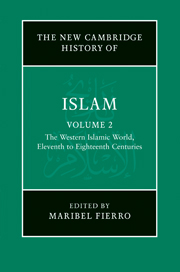Book contents
- Frontmatter
- Introduction
- PART I AL-ANDALUS AND NORTH AND WEST AFRICA (ELEVENTH TO FIFTEENTH CENTURIES)
- 1 Al-Andalus and the Maghrib (from the fifth/eleventh century to the fall of the Almoravids)
- 2 The central lands of North Africa and Sicily, until the beginning of the Almohad period
- 3 The Almohads (524–668/1130–1269) and the Ḥafṣids (627–932/1229–1526)
- 4 The post-Almohad dynasties in al-Andalus and the Maghrib (seventh–ninth/thirteenth–fifteenth centuries)
- 5 West Africa and its early empires
- PART II EGYPT AND SYRIA (ELEVENTH CENTURY UNTIL THE OTTOMAN CONQUEST)
- PART III MUSLIM ANATOLIA AND THE OTTOMAN EMPIRE
- PART IV NORTH AND WEST AFRICA (SIXTEENTH TO EIGHTEENTH CENTURIES)
- PART V RULERS, SOLDIERS, PEASANTS, SCHOLARS AND TRADERS
- Glossary
- Bibliography
- Index
- References
1 - Al-Andalus and the Maghrib (from the fifth/eleventh century to the fall of the Almoravids)
from PART I - AL-ANDALUS AND NORTH AND WEST AFRICA (ELEVENTH TO FIFTEENTH CENTURIES)
Published online by Cambridge University Press: 28 March 2011
- Frontmatter
- Introduction
- PART I AL-ANDALUS AND NORTH AND WEST AFRICA (ELEVENTH TO FIFTEENTH CENTURIES)
- 1 Al-Andalus and the Maghrib (from the fifth/eleventh century to the fall of the Almoravids)
- 2 The central lands of North Africa and Sicily, until the beginning of the Almohad period
- 3 The Almohads (524–668/1130–1269) and the Ḥafṣids (627–932/1229–1526)
- 4 The post-Almohad dynasties in al-Andalus and the Maghrib (seventh–ninth/thirteenth–fifteenth centuries)
- 5 West Africa and its early empires
- PART II EGYPT AND SYRIA (ELEVENTH CENTURY UNTIL THE OTTOMAN CONQUEST)
- PART III MUSLIM ANATOLIA AND THE OTTOMAN EMPIRE
- PART IV NORTH AND WEST AFRICA (SIXTEENTH TO EIGHTEENTH CENTURIES)
- PART V RULERS, SOLDIERS, PEASANTS, SCHOLARS AND TRADERS
- Glossary
- Bibliography
- Index
- References
Summary
Sources of information
Our understanding of al-Andalus and the Maghrib in the fifth/eleventh century is largely based on textual sources, primarily historical narratives but occasionally documents of a different nature, such as those of the Cairo Geniza (a chamber of the synagogue in Fusṭāṭ that served as the burial room for the various kinds of writing that originated within the Jewish community). This documentary evidence is increasingly being complemented by the fruits of archaeological excavation, numismatics and epigraphy. Here only the main documentary sources dating from the period in question will be dealt with.
The writings of Ibn Ḥayyān (d. 469/1076) and Ibn Ḥazm (d. 456/1064) represent the spectacular double finale to the chronicles of the Umayyad period. They both show a keen critical insight into the changes brought about by the fall of the Umayyad regime in the first years of the fifth/eleventh century, and give us valuable information about the Taifa kingdoms that followed. The Matīn, Ibn Ḥayyān’s great compendium, unfortunately only survives in the form of quotations by later authors.
Al-ʿUdhrī (d. 478/1085) devoted particular attention to his patrons, the Banū Ṣumādiḥ of Almería. Though al-ʿUdhrī’s text has not been preserved in its entirety, the historical and geographical details provided by the surviving parts stand out for a certain originality of analysis. Al-Bakrī (d. 487/1094), son of the deposed Taifa king of Huelva, is acknowledged to be the best Andalusi geographer.
- Type
- Chapter
- Information
- The New Cambridge History of Islam , pp. 19 - 47Publisher: Cambridge University PressPrint publication year: 2010
References
- 2
- Cited by

